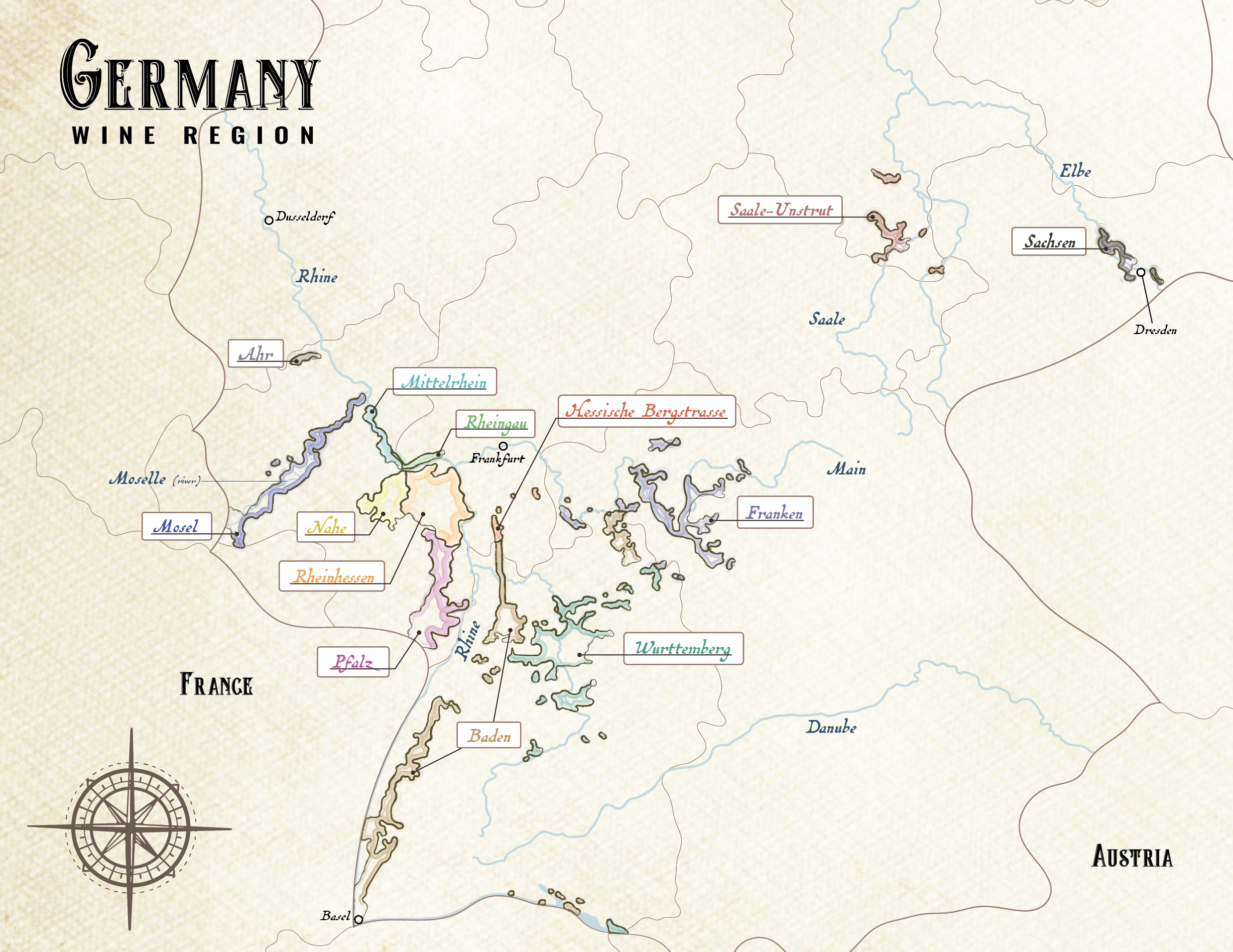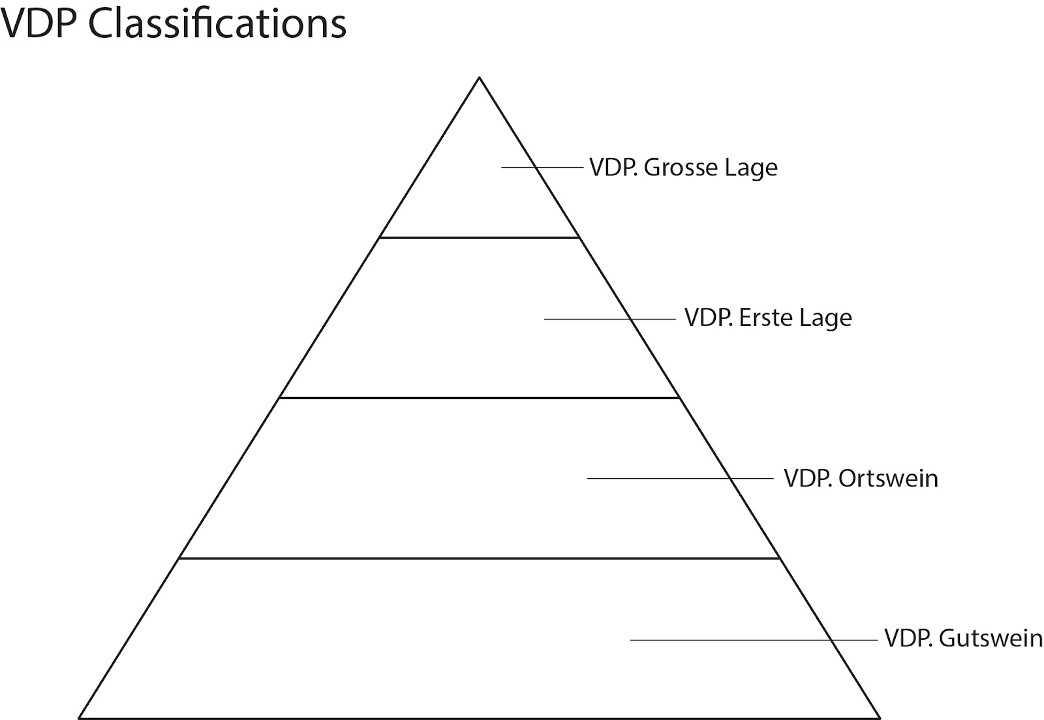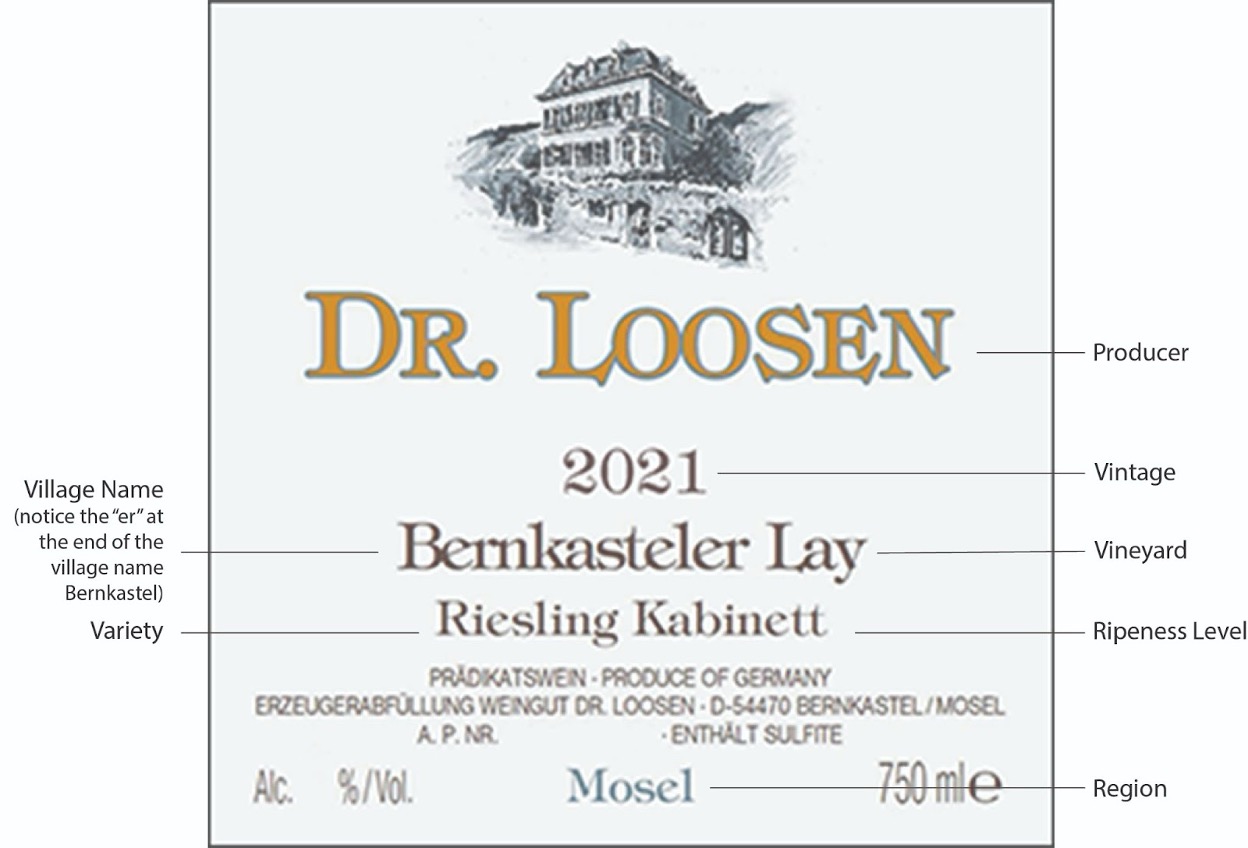- Main white grapes:
- Riesling is the most important grape in Germany
- It is used to make all the top wines
- It is never blended with other grapes
- Main red grapes:
- Spätburgunder (Pinot Noir)
- 70 percent of wines produced in Germany are whites
- Germany is responsible for less than 5 percent of the world’s total wine production however they are responsible for nearly 60 percent of the worlds Riesling production
- There are 13 anbaugebiete (“an-bow-ga-beat-te”) which are legally designated wine producing regions:
- Ahr, Baden, Franken, Hessische Bergstrasse, Mittelrhein, Mosel, Nahe, Pfalz, Rheingau, Rheinhessen, Saale-Unstrut, Sachsen, Württemberg
- Top regions are Mosel, Rheingau, and Pfalz
- German vineyards lay on the northern most latitude of where grapes can grow (the range is 30-50 degrees north and south latitudes).
- Most vines are planted along the Rhine or Mosel Rivers which moderate the area’s otherwise severe climate - the soil is made up of heat retaining slate and basalt.
- Most top wines are made dry (trocken) with the exceptions of late harvest wines BA’s, TBA’s, and Eisweins which are all sweet
Some helpful terms and definitions
- Germany is made up of 13 regions called “anbaugebiete” (“an-bow-ga-beat-te”)
- Those 13 anbaugebiete are divided into 39 districts called “bereiche”
- The 39 districts are divided into 167 groupings of vineyards each called a “grosslage”
- Each individual vineyard is call an “einzellage”
- Vice: meaning “white”
- Grow: meaning “gray”
- Sekt (“zekt”): is sparkling wine, top versions use the traditional method and are made from Riesling, Weissburgunder (Pinot Blanc), and/or Blauburgunder (Pinot Gris)
- Burgunder: meaning the Burgundy wine region of France and refers to pinot. Therefor Spätburgunder is the late grape from burgundy or Pinot Noir, Viceburgunder is the white pinot or Pinot Blanc, and Growburgunder is Pinot Grigio
- Lese (“lay-za”): to harvest or pick
- Combining Spät (meaning “late”) with lese = Spätlese meaning wine that is made from grapes that are picked late in the harvest
- Aus: means “out,”
- Therefore, Aus + lese = Auslese means to pick out referring to specific bunches or clusters of grapes that a determined to be ripe enough and therefor “picked out” to be used for Auslese wines
- Beeren: means “berry,”
- Therefore, Beeren + aus + lese = Beerenauslese meaning wines that are fermented from grapes where the individual berries (rather than the clusters) are picked out. As you can imagine this is very labor intensive and thus translates to higher prices
- Trocken: means “dry”
- Therefore, Trocken + beeren + aus + lese = Trockenbeerenauslese meaning wines that are fermented from grapes where dry berries are picked out. These are botrytis affected grapes which is what dries them out causing them to become raisin-like while still on the vines. These grapes have high concentration of sugar due to the lack of water within the grape, thus producing low yields of highly concentrated sweet wine.
- Eiswein: meaning ice wine, is wine that is produced from grapes that have frozen on the vines. This happens when the temperature in the field drops to a certain point (roughly -6 or -7 degrees celsius), typically at night, which causes the water (but not the sugars) within the grapes to crystallize. The grapes are then picked and pressed (while still frozen), extracting the sugars and leaving the water behind. This produces a highly concentrated sweet syrup in the same way that sucking on an ice pop pulls out all the sugary goodness leaving behind a flavorless piece of ice. There is no botrytis influence in these wines.
- Gemeinde: is a German municipality. For wine, it refers to a wine producing village.
- The letters “er” at the end of a village name means “of” or “from that village” in the same way that a New Yorker is from New York. Ex: a wine label that says Ürziger is a wine that comes from the village of Ürzig.
- Landwein (PGI): Regional wines
- Grow: meaning “gray”
- Qualitätswein (PDO): these are quality wines that come from one of 13 specific wine regions. These regions are called Anbaugebiete (“An-bow-ga-beat-te”). Wines from this category are taste tested and must meet certain quality standards to gain Qualitätswein designation
- Prädikatswein (PDO): is a subsection of Qualitätswein where wines are categorized into one of six quality levels The quality levels are based on the ripeness of the grapes (concentration of sugar within the grapes) when they are harvested.
- In order from highest quality, and concentration of sugar, to lowest:
- Trockenbeerenauslese (TBA)
- Eiswein
- Beerenauslese
- Auslese (can be made sweet or dry)
- Spätlese (can be made sweet or dry)
- Kabinett (can be made sweet or dry)
- VDP (Verband Deutscher Prädikatsweingüter) : this is a classification system that exists outside of the PDO system. It was founded in 1910 and is an association of 200 of Germany’s top wine producers committed to producing the dry Rieslings from the best vineyards. The VDP has higher restrictions than the PDO system and is intended to emulate the grand cru system of Burgundy. These wines will be marked with their signature eagle on the neck of each bottle.
Germany’s hierarchy for ripeness is based on harvesting in passes of the vineyard. Due to unpredictable weather, producers will do an early sweep of the vineyard pulling a certain amount of grapes. These will be used to make “Kabinett” wines, the lowest level of ripeness. The rest of the grapes will be left on the vines to continue ripening. As long as the weather holds up without anything, like frost, damaging the vines, after some time they will do a second sweep of the vineyards harvesting grapes to make the next level of ripeness, “Spätlese, again leaving the rest of grapes on the vines to continue ripening. They will repeat this process making their way through as many ripeness levels as the season's weather will allow (which is not always all of them).
- Due to Germany’s geographic location and cold climate, grapes did not always ripen to consistent levels. Because of this, two categories are used on labels to describe the wines.
- The first describes the ripeness level of the grapes. This is the Kabinett through Eiswein scale
- The second is the sweetness level that the wine is made to ( trocken for dry, halbtrocken for half dry, and lieblich which are sweeter)
- Both categories are indicated on the label for example “kabinett trocken,” “kabinett lieblich,” or “auslese trocken”
- The VDP’s philosophy is “the narrower the origin, the higher the quality” (4). To learn more about the VDP and their classification system, check out their website
- Uses kabinett through TBA to describe sweetness levels in wine rather than ripeness levels in grapes as is the case with the Traditional System
- VDP’s Hierarchy:
- Gutswein: “goots-wine” meaning good wine is basic table wine, labeling optional
- Ortswein: village wine. Labeling optional
- Erste Lage: representative of Burgundy’s Premier Cru, must be indicated on label
- Grosse Lage: is similar to the Grand Cru of Burgundy and must be indicated on label
- The best most age worthy wines
- Also called/labeled “Grosses Gewächs” meaning great growth or “G.G.” for dry wines
- Sweet versions will be labeled kabinett through TBA depending on sweetness level
- If no sweetness level is indicated on label then the wine is dry




